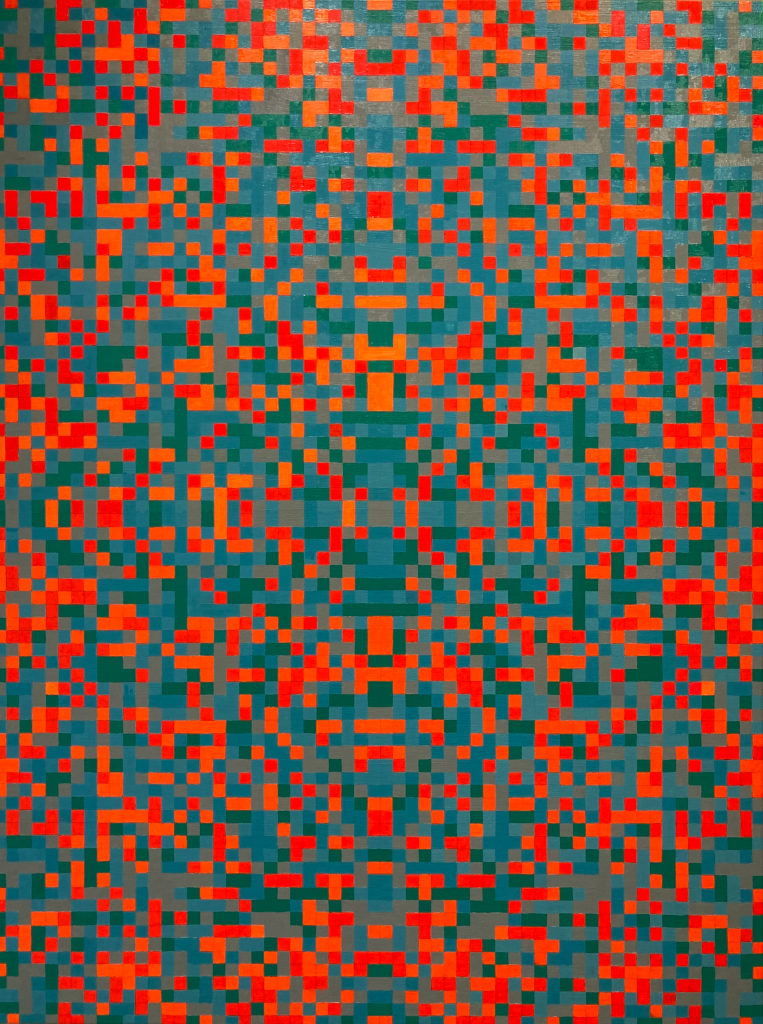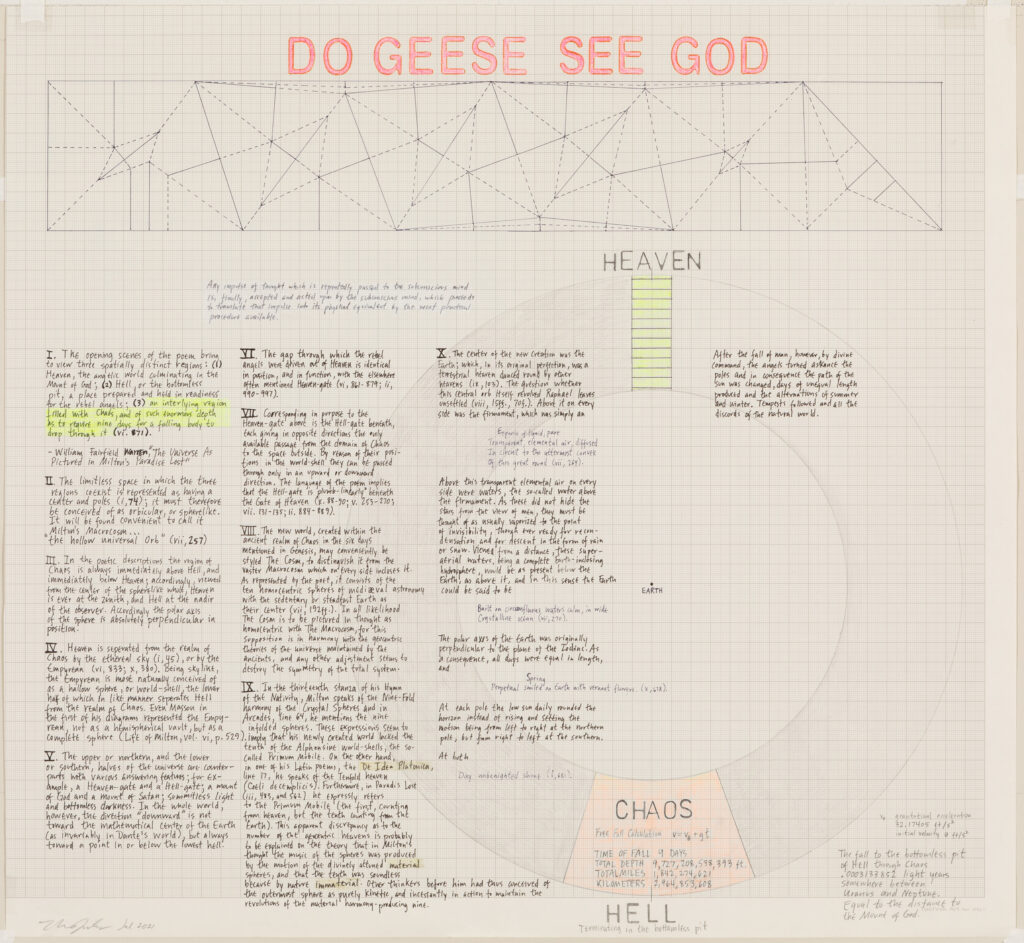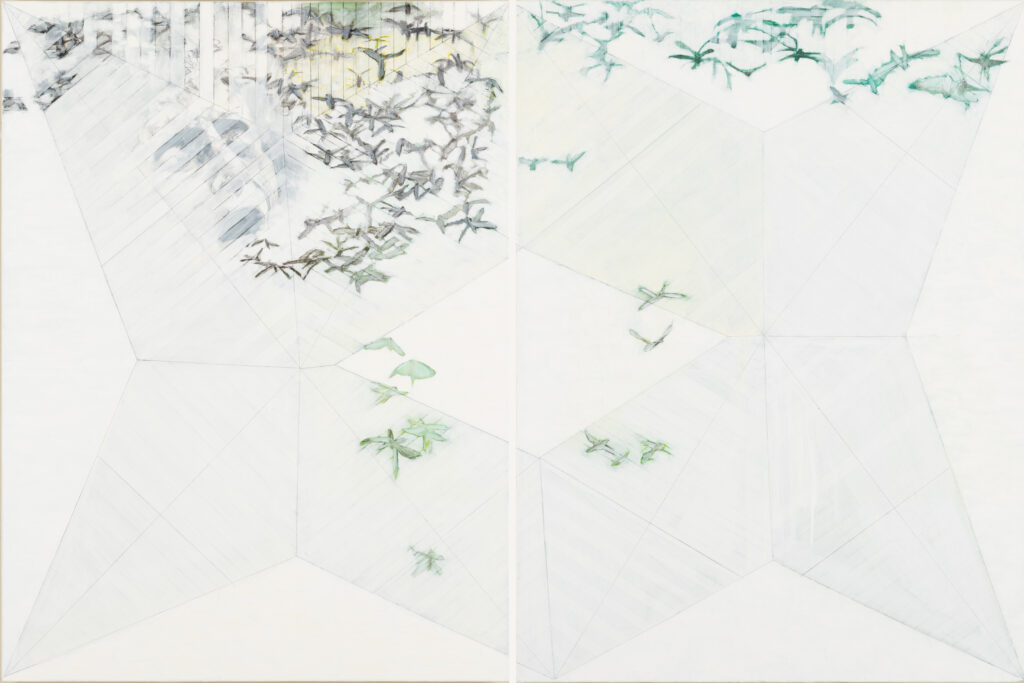For 2022-2023, my attention is with optical palindromes. These are visuals that are horizontally and vertically repeated and inverted. Palindrome structures have a rich and varied history in the sciences, architecture, nature, and religion. I write programs in Processing to rapidly generate layouts and assist me in my work. Once refined, these layouts are created as drawings and paintings expressing a palindrome structure. Composed of squares of color on a grid, I find these works optically vibrate in circular rhythms defying their rectilinear structures and hinting at a space in between that’s not quite physical, a kind of free fall.
Why palindromes? I became obsessed with a work written in 1915 by William Fairfield Warren titled “The Universe as Pictured in Milton’s Paradise Lost”. In his text, Warren constructs ten visual renderings of the universe according to Milton’s text and it reads much like a vigorous attempt to map the unmappable as there are few spatial constraints present in “Paradise Lost”. This text was used as a teaching tool for a class on religion at Boston University. Warren describes his effort saying “diagram lines and angles and measurements are helpless and worse than helpless in the representation of beings and movements essentially superspatial and supertemporal”.
In Warren’s work I find a theme and drive common to my own; a strong desire to define subjective complexities in a way that brings clarity and ultimate safety. Warren describes the opening scene of Milton’s “Paradise Lost” as having divided creation into three distinct areas: Heaven, Hell, and an “interlying region filled with Chaos, and of such enormous depth as to require nine days for a falling body to drop through it”. This got me running to my calculator to determine how far a body in free fall would travel in nine days. It turns out the distance between Heaven and Hell is 1,842,274,621 miles or .0003133852 light years which if traversed from Earth would take you somewhere between Uranus and Neptune.
My thoughts turned to free fall and I was swept up in the history of space dives pioneered by Joseph Kittinger and the US Air Force in 1960. During these experiments, the goal, aside from making a safe landing, was to control the characteristic spin that occurs when falling from the outer edge of our atmosphere to ground. In reviewing the historical video footage, I made note of the position of the recording film camera. It was either viewing the falling body as it plunged to Earth in a straight line or mounted to the falling body and spinning wildly. The combination of these points of view, objective and subjective, co-create a perception of these high altitude jumps and the experience of free fall. This idea of complementary opposites, and more specifically, chiral forms (a non-superimposable set of two structures that are the mirror image of one another) led to further research into chirality as it appears in nature, and ultimately palindromes.
The word “chiral” derives from the Greek word for “hand”, perhaps because our hands are a good example of chirality. In this context, I find it both humorous and uplifting to think that “having a grip on reality” means directing the inevitable and characteristic spin so you don’t pass out while having an overwhelming sensory experience. This means you have the opportunity to enjoy the ride.

40″ x 30″, oil on canvas, 11/19/2023

40″ x 30″, oil on canvas, 9/18/2023

30″ x 22″, black pencil on paper, 8/29/2023

40″ x 30″, oil on canvas, 6/1/2023

30″ x 22″, ink on paper, 12/25/2022

30″ x 22″, ink on paper, 1/17/2023

59″ x 37.75″, blue ink on Yupo, 1/26/2023

30″ x 22″, claret ink on paper, 2/20/2023

30″ x 22″, stamped ink on paper, 4/2/2023

31″ x 17″, stamped ink on Yupo, 4/27/2023

38″ x 22″, stamped ink on Yupo, 5/20/2023

30″ x 22″, ink on paper, 9/2/2022

30″ x 22″, graphite on cream paper, 8/24/2022

30″ x 22″, ink on paper, 9/15/2022

30″ x 22″, ink on paper, 8/29/2022

24″ x 36″, ink and colored pencil on graph paper, 6/2022

30″ x 22″, ink on paper, 9/4/2022

30″ x 22″, ink on paper, 9/3/2022

25.25″ x 22″, gouache and ink on paper, 9/19/2022

36″ x 24″, ink on graph paper, 6/22/2022

36″ x 24″, ink on graph paper, 6/24/2022

36″ x 24″, ink on graph paper, 7/13/2022

18.75″ x 20.5″
ink and colored pencil on graph paper, 7/1/2021

24″ x 36″, colored pencil on graph paper, 3/24/2022

30″ x 22″, gouache on paper, 5/1/2022

36″ x 36″, oil on canvas, 11/2022

40″ x 30″, oil on canvas, 1/2023

34″ x 61″, oil on canvas, 2/16/2023

40″ x 60″ diptych, oil on canvas, 2022